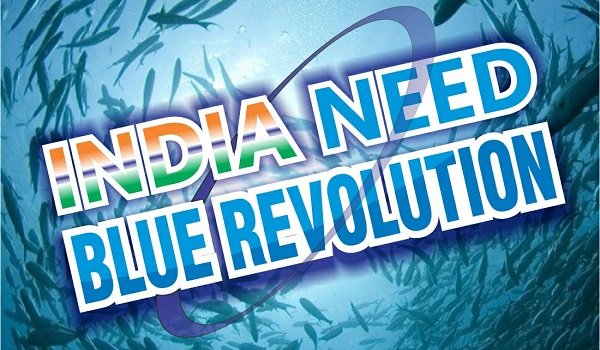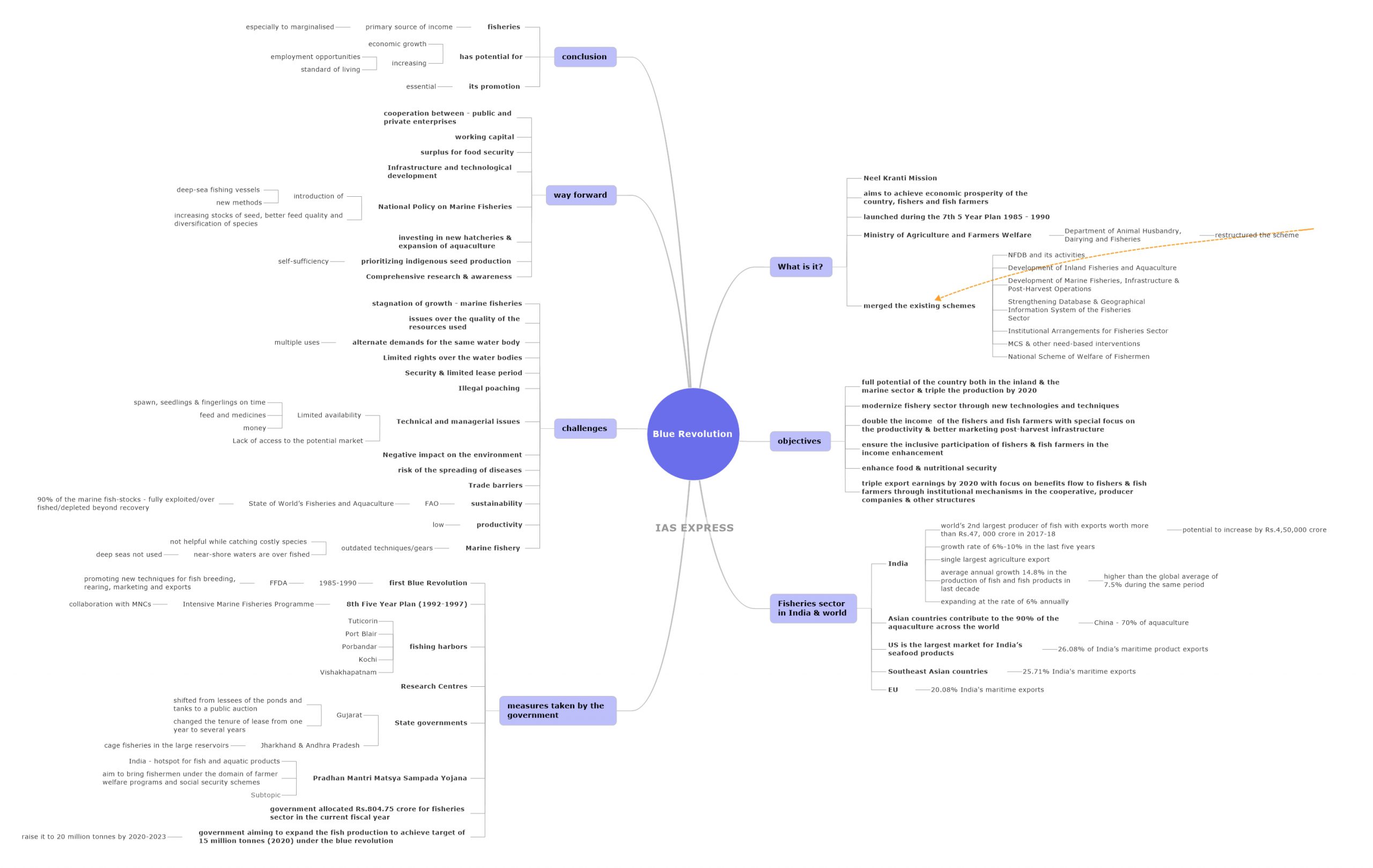Blue Revolution in India and its Importance

This year, Vice-President Venkaiah Naidu had inaugurated the fifth edition of the Aqua Aquaria India in Hyderabad. The theme for this year’s event is – ‘Taking Blue Revolution to India’s Hinterland’. Blue Revolution is one of the major schemes by the Indian government to promote fishing as an allied activity for the farmers. It is the term used to describe the fast-paced growth of the aquaculture industry in India. Fish is a major source of income for the marginalised section of society. However, its potential is not seen at the ground level. The government must undertake all possible measures to promote the fisheries and aquaculture sectors of the country as it can be an essential tool to help lift the marginalised societies from the shackles of social and economic constraints.
This topic of “Blue Revolution in India and its Importance” is important from the perspective of the UPSC IAS Examination, which falls under General Studies Portion.
What is the Blue Revolution?
- The Blue Revolution or Neel Kranti Mission is a scheme that aims to achieve economic prosperity of the country, fishers and fish farmers.
- It also seeks to contribute towards the food and nutritional security of the country through the full potential utilization of water resources for fisheries development in a sustainable manner, keeping in view the bio-security and environmental concerns.
- It was launched during the 7th Five Year Plan that went on between 1985 and 1990
- The Ministry of Agriculture and Farmers Welfare’s Department of Animal Husbandry, Dairying and Fisheries have restructured the scheme by merging the on-going schemes under the umbrella of the Blue Revolution.
- The Blue Revolution now has the following components:
- NFDB and its activities
- Development of Inland Fisheries and Aquaculture
- Development of Marine Fisheries, Infrastructure and Post-Harvest Operations
- Strengthening of the Database and Geographical Information System of the Fisheries Sector
- Institutional Arrangements for the Fisheries Sector
- Monitoring, Control, and Surveillance (MCS) and other need-based interventions
- National Scheme of Welfare of Fishermen
What are the objectives of the Blue Revolution?
- To obtain the full potential of the country both in the inland and the marine sector and triple the production by 2020.
- To transform the fisheries sector into a modern industry with special focus on new technologies and techniques.
- To double the income of the fishers and fish farmers with special focus on productivity and better marketing through postharvest infrastructure including e-commerce and other technologies and best international innovations.
- To ensure the inclusive participation of the fishers and fish farmers in income enhancement.
- To triple the export earnings by 2020 with a focus on the benefits flow to the fishers and fish farmers through institutional mechanisms in the cooperatives, producer companies, and other structures.
- To enhance the food and nutritional security of the country.
What is the contribution of the fisheries sector to the Indian economy?
- India is the world’s second-largest producer of fish with exports worth more than Rs.47, 000 crore in 2017-18 and has the potential to be increased by Rs.4,50,000 crore.
- In fact, Asian countries contribute to 90% of the aquaculture across the world.
- China by itself contributes more than 70% of the aquaculture.
- Fisheries are India’s single largest agriculture export.
- The US is the largest market for India’s seafood products. It obtains 26.08% of India’s maritime product exports.
- After the US, the Southeast Asian countries and the EU acquire 25.71% and 20.08% of India’s maritime exports
- It has a growth rate of 6%-10% in the last five years. This is far better in comparison with the farm sector during the same period with growth by 2.5%.
- India has an average annual growth of 14.8% in the production of fish and fish products in the last decade. This is higher than the global average of 7.5% during the same period. It is expanding at a rate of 6% annually.
- Thus, it has a huge potential to address issues of employment opportunities of the marginal communities and the growing global demand for fish products.
What are the measures taken by the government to utilize the potential of the fisheries sector?
Fish Farmers Development Agency (FFDA):
- India had first launched the Blue Revolution during the Seventh Five-Year Plan that took place between 1985 and 1990.
- During this period, the government had launched the Fish Farmers Development Agency (FFDA).
- FFDA had improved the aquaculture by promoting new techniques for fish breeding, rearing, marketing, and exports.
Intensive Marine Fisheries Programme:
- During the 8th Five Year Plan (1992-1997), the Intensive Marine Fisheries Programme was launched.
- This was done in collaboration with multinational companies.
Fishing Harbours were established in Tuticorin, Porbandar, Kochi, Vishakhapatnam, and Port Blair.
Research Centres were also established to increase the productivity of this sector. This initiative had picked up speed during 2014 under the Modi Government.
The State Governments have also contributed to the growth of this sector.
- Gujarat had shifted from lessees of the ponds and tanks to a public auction. It has also changed the tenure of lease from one year to several years. This move had provided huge incentives for private entrepreneurs. It also increased production in this sector. The private entrepreneurs are strengthening the ponds and other related infrastructures and are replenishing the dried-up waters. They even finance the protection of fishes against poachers.
- Jharkhand and Andhra Pradesh are yielding high returns from cage fisheries in large reservoirs. This process involves the rearing of fishes in the existing water resources while being enclosed in a net cage to allow the free flow of water.
Pradhan Mantri Matsya Sampada Yojana:
- a Central Government scheme seeks to turn India into a hotspot for fish and aquatic products through appropriate policy for marketing and infrastructure aids.
- The government, through this scheme, aims to bring all the fishermen under the domain of farmer welfare programs and social security schemes.
- The new scheme was introduced under the newly formed Department of Fisheries that was announced during the interim budget.
Budget: The government has also allocated Rs.804.75 crore for the fisheries sector in the current fiscal year.
Target: The aim is to expand the fish production to achieve the target of 15 million tonnes by 2020 under the blue revolution and raise it to 20 million tonnes by 2020-2023
What are the challenges faced by India’s fisheries sector?
- There are concerns about the stagnation of growth in marine fisheries.
- There are issues over the quality of the resources used.
- It may be due to the length of time for which water should be stagnated within a water body.
- There are alternate demands for the same water body leading to the multiple uses of the same.
- Limited rights over the water bodies.
- Security and the limited lease period.
- Illegal poaching of fish.
- Technical and managerial issues like
- Limited availability of spawn, seedlings, and fingerlings during the necessary time frame.
- Limited availability of feed and medicines.
- Lack of access to the potential market.
- Limited availability of working capital in the sector
- Negative impact on the environment
- Increase in the risk of the spreading of diseases
- Trade barriers
- There is a challenge of sustainability in this sector. The FAO’s State of World’s Fisheries and Aquaculture reports state that nearly 90% of the marine fish-stocks has been fully exploited or overfished or depleted to an extent that recovery maybe not biologically possible.
- The productivity in terms of per fisher, per boat, per farm, is very low:
- In Norway, a fisherman or a fish farmer catches or produces 250kg /day. In India, it is just 4-5kg/day.
- The Marine fishery mostly consists of small scale fishermen who operate in traditional methods using non-motorized boats or boats with basic onboard motors.
- These vessels cannot function beyond nearshore waters.
- They are not helpful while catching costly species like tuna.
- Due to these reasons, the near-shore waters are overfished while the high-value fish thrives in the deeps seas – a place where the fishermen don’t have access
Way Forward:
Cooperation: There must be an increase in the cooperation between the public and private enterprises in this sector for it to grow.
Capital:
- The government should provide for flexible and easily available working capital for this sector. The absence of it is clearly hindering the aspirations of the Indian government.
- The surplus must be used for food security within the country.
Infrastructure and technological development is a need of the hour given the low production capacity of the individual fishers in the country.
- The National Policy on Marine Fisheries is calling for the introduction of deep-sea fishing vessels and assisting those working in this sector to convert their traditional vessels and gears to the new technologically advanced vessels and gears. This would help the marine fishing community.
- This policy also aims for intensive fish farming by increasing the stocks of seed, better feed quality and diversification of species.
- More areas should be used for fish farming by investing in new hatcheries and the expansion of aquaculture.
Indigenous seed production: The policies must focus on giving priority to the indigenous seed production to ensure self-sufficiency in this sector
Comprehensive research and awareness must be promoted in this sector.
In doing so, this sector may reach its full potential
Conclusion:
Fishing related activities are the primary source of income for several communities –especially for those who are socially and economically marginalized in India. It has enormous potential in the promotion of the country’s economic growth, employment opportunities and standard of living. Thus, this sector must be endorsed through technological and infrastructural developments for it to become a major driver of the Indian economy.



NICE